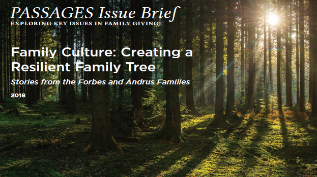Family Culture: Creating a Resilient Family Tree (Excerpt)

Revisitation and Affirmation – Keeping It Relevant
The landscape of family culture is subjected to constant pressure from outside as the world we live in changes. This is true regardless of the size of your family or the number of generations that you track in your past. In that context, how do you hold onto core shared values that inform your family culture when the ground is constantly shifting beneath your feet? And how do you know what’s OK to shift or tweak and what is part of the bedrock of your family identity and common connection?
This takes a combination of clarity and intuition and requires regularly revisiting these shifts over time. Families must be clear about how to evolve with external pressure while remaining true to their bedrock values. It may be one person or perhaps a group who become keepers of your family’s core cultural values. In the context of multiple generations, there may be a more formal council, Board or committee that is charged with, among other things, protecting the family culture.
These cultural gatekeepers are responsible for striking a balance between resisting any change (because change, of course, is inherently filled with the unknown) and identifying what changes make sense so that your family’s cultural identity remains strong for all members regardless of age. Resisting change for the sake of maintaining tradition can feel like protecting the family culture. But preventing change also creates risk: resisting all change will erode your family’s cultural identity, particularly among younger generations who lack the context from the past and are highly tuned into remaining relevant. Defining what aspects of your family culture must remain and what can shift is the work of those responsible for stewarding your family culture. And, of course, even with cultural gatekeepers focusing on family culture, some change is inevitable.
The Forbes family has several different groups of family members who nurture family culture by recognizing history and tradition while also maintaining cultural relevance. Some of these activities are formal committees while others may have begun as a small project and have evolved over time. Two examples of how this comes to life are in our family tree project and in our approach to technology upgrades.
“About 30 years ago, one cousin took it upon herself to create a large-scale family tree using the second floor of a barn. Little note cards identified family members, with each branch of the family assigned a color, and each card connected by yarn. The project grew and evolved with each year, and now with tape replacing the yarn, we also have printed books, electronic versions of the very analog card-based “tree” in the barn and even different exhibits that display art and artifacts from various family members. Despite the different changes to the space and options for accessing the genealogy info, the original card-based version remains and is a regular destination for those looking to discover and explain how we’re related and to celebrate our collective history.”

In a family that cherishes tradition, rapidly evolving technology creates many challenges, and the changes we have made in the face of available technology are always carefully considered. Most change has been focused around practical management realities, and what many outside our family would consider an upgrade or update is typically shunned or simply declined.
So, you can imagine the debates that occur around the question of whether to invest in high speed internet for the property. The prevailing wisdom has been that ‘we come here to get away from all that.’ Broadband speeds mean people can hole up in their room binge-watching the latest season of “Game of Thrones” instead of playing cards, joining a game of charades, swimming or exploring. Changes brought about from rapidly evolving technology can feel like a direct threat to how we spend time together.
When Kelly’s family foundation, Surdna, established its first next generation program in 2000, they did not mandate how the program should be defined. The fourth generation of the Surdna Board empowered those fifth-generation family members to build the governance structures, program areas, and yes, the culture, of the program. The Andrus Family Fund, known nationally for its work in foster care and juvenile justice, tended to culture from the beginning, creating an officer position called the “Transitions Keeper.” The founding board members of the Andrus Family Fund applied a transitions framework in the approach to their work. This framework taught them the importance in marking moments, in understanding how we all respond to change in different ways and at different paces.
In the face of tradition, these questions can either feel obvious, or they can ignite controversy because tradition lies at the heart of the matter. And the fear is that changing traditions may begin to unravel the connections that bind you together as a family. This is why it’s important to be thoughtful and strategic about how to sustain the shared core values in your family culture, while also recognizing that how they are interpreted may require occasional shifts to remain relevant. Cultural gatekeepers ensure that families sustain their collective identity and sense of connectedness over time by watching over and revisiting their cultural norms, adjusting or confirming along the way that “this is how we do it” while also recognizing that how we do it today might have to be different next year.

To learn more about this important topic, check out NCFP’s Passages paper: Family Culture: Creating a Resilient Family Tree.

